![]() Return to: "The Chambered Nautilus".
Return to: "The Chambered Nautilus".
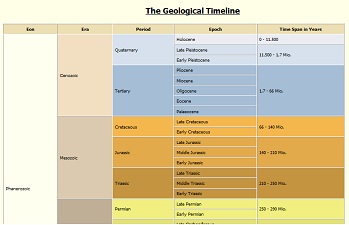 Geological Timeline. |
Contrary to only 650 species known today of recent cephalopods, there are more than 7500 proven from fossil remains. The first fossil cephalopods appeared in the Cambrian period more than 500 million years ago.
The class Cephalopoda today is divided into three subclasses, of which only two are still present on earth with recent species: The archaic Nautiloidea, relatives of the nautilus, and the more "modern" Coleoidea, relatives of octopuses, squids and cuttlefish.
The third subclass, Ammonoidea, relatives of the Ammonites, by the end of the Cretaceous period more than 60 million years ago, has become completely extinct.
Most interestingly the first cephalopods to appear in the Cambrian period were relatives of the nautilus, called Ellesmeroceratida.
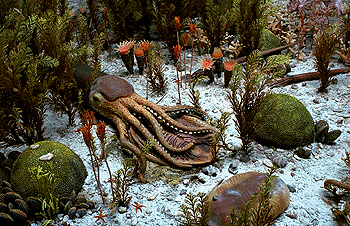 A scene from the Ordovician: Cameraceras feeds on a trilobite. Source: R. Thomas, C. Wozniak: Earth History Resources. |
They were a part of the order Endoceratida, other species of which appeared later, in the Ordovician period (485 to 444 millions of years ago), in giant size: The giant endocerate Cameraceras had a presumed overall length of over 30 feet, longer than a bus, and tentacles more than 3 feet long. Cameraceras was the largest carnivore of its time, even to be feared by the giant scorpions, which shared its seas.
Cameraceras was also the only mollusc to be mentioned in the BBC movie "Chased by Sea Monsters – Prehistoric Predators of the Deep".
Endocerates, like Cameraceras, did not yet have a coiled shell. Their shell was straight, like a horn. So in former times, the fossil remains of straight cephalopod shell were thought to be a unicorn's horn.
The largest number of fossil species in Nautilus relatives appear between the Silurian and late Carboniferous periods with the Oncoceratida and the Orthoceratida. The Nautilus relatives decreasing in numbers, another group of cephalopods already was taking their place – the Ammonoidea subclass with the best known fossil cephalopods – the ammonites.
Of those for example the Goniatitida are important index fossils in the different stone layers from the Carboniferous. The ammonites as such (the order Ammonitida) only appeared during the Triassic, but grew to a large number of species during the Jurassic and the Cretaceous periods.
Other than the Nautiloidea, the Ammonitoidea, as already mentioned, were gone by the end of the Cretaceous.
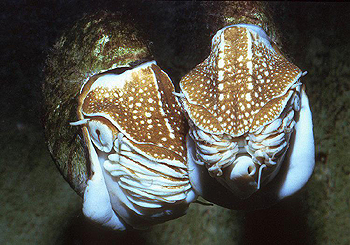 Nautilus pompilius. Picture: Vladimír Motyčka, biolib.cz. |
There are only few species living today, which merit the term "Living Fossil". In principle, this is a contradiction in terms, as, of course, fossils do not live. In the phylum of molluscs there are, on the other hand, even two groups, which are called that way, Nautilus and Neopilina. Living fossils usually are the last relics of a group extinct for a long time. They are recognisable by appearing in a very little number of recent species, but a very large number of fossil relatives. From their more "modern" recent relatives they are usually different by a number of archaic characters not elsewhere to be found in the respective systematic group. Systematically they are the only recent members of a systematic large group (such as an order or even a subclass).
Nautilus is a good example for a living fossil:
![]() Nautilus and its nearest relative,
Allonautilus, are the only recent
cephalopods armed with a coiled external shell. All other cephalopods' shells
are at least internal, or, as in the case of the octopuses, completely reduced.
Nautilus and its nearest relative,
Allonautilus, are the only recent
cephalopods armed with a coiled external shell. All other cephalopods' shells
are at least internal, or, as in the case of the octopuses, completely reduced.
![]() Nautiluses also are different from other recent cephalopods in having two
pairs of gills instead of one. That is why the Nautiloidea also go by the name
of Tetrabranchiata, meaning four-gill cephalopods.
Nautiluses also are different from other recent cephalopods in having two
pairs of gills instead of one. That is why the Nautiloidea also go by the name
of Tetrabranchiata, meaning four-gill cephalopods.
![]() Contrary to other cephalopods having no more than eight (octopuses) or ten (squids,
cuttlefish) tentacles, nautilus own a many – about 90 – of them. Its tentacles,
besides, are not equipped with suckers, but with sticky cilia that make adhesive
pads to hold the prey.
Contrary to other cephalopods having no more than eight (octopuses) or ten (squids,
cuttlefish) tentacles, nautilus own a many – about 90 – of them. Its tentacles,
besides, are not equipped with suckers, but with sticky cilia that make adhesive
pads to hold the prey.
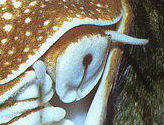 A nautilus eye. Source: as above. |
![]() Further characters of nautilus are its primitive eyes. Whereas the other
recent cephalopod species are equipped with the most highly developed lens eyes
among all invertebrates, Nautilus only has primitive eyes at its disposition: A
nautilus eye works like a camera obscura or pinhole camera. The picture is
sharpened by closing the pupil, which of course goes together with a reduced
amount of light coming though.
Further characters of nautilus are its primitive eyes. Whereas the other
recent cephalopod species are equipped with the most highly developed lens eyes
among all invertebrates, Nautilus only has primitive eyes at its disposition: A
nautilus eye works like a camera obscura or pinhole camera. The picture is
sharpened by closing the pupil, which of course goes together with a reduced
amount of light coming though.
The genus Nautilus as such has been living on earth probably since the Cretaceous, but certainly since the Eocene, 38 million years ago. Fossil remains of the group have been found all over the earth, but recent Nautilids only occur in a part of the Pacific Ocean.
Another living fossil from the mollusc phylum is Neopilina, an archaic mollusc resembling a limpet. Unlike the limpet (a sea gastropod) Neopilina is a part of the Tryblidia class (formerly known as Monoplacophora) and though the shell roughly does look like a limpet, Neopilina's body is almost completely of another composition, both only related in both being molluscs.
Other well known non-mollusc living fossils are the horseshoe crab Limulus, the coelacanth Latimeria and the tuatara lizard (Sphenodon).
width="603">
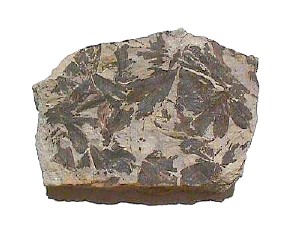
 |
A living fossil from the plant kingdom is Gingko (Gingko biloba). The leaves of the recent tree are only a little different from those of its 170 million year old fossil ancestor. Source: Wikipedia. |